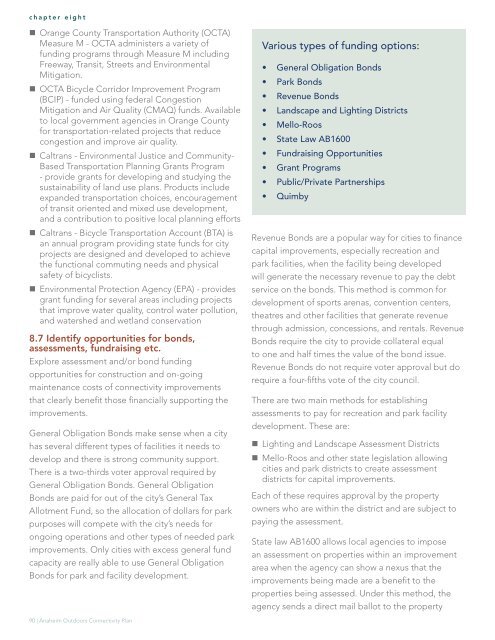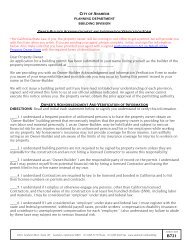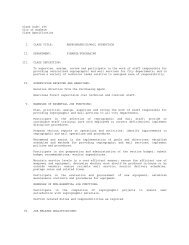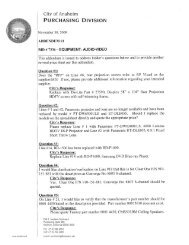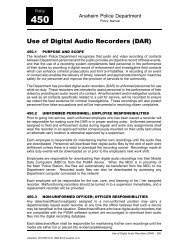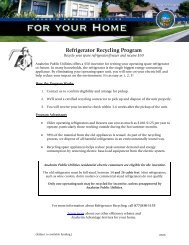AnaheimOUTDOORS - City of Anaheim
AnaheimOUTDOORS - City of Anaheim
AnaheimOUTDOORS - City of Anaheim
You also want an ePaper? Increase the reach of your titles
YUMPU automatically turns print PDFs into web optimized ePapers that Google loves.
chapter eight<br />
• Orange County Transportation Authority (OCTA)<br />
Measure M - OCTA administers a variety <strong>of</strong><br />
funding programs through Measure M including<br />
Freeway, Transit, Streets and Environmental<br />
Mitigation.<br />
• OCTA Bicycle Corridor Improvement Program<br />
(BCIP) - funded using federal Congestion<br />
Mitigation and Air Quality (CMAQ) funds. Available<br />
to local government agencies in Orange County<br />
for transportation-related projects that reduce<br />
congestion and improve air quality.<br />
• Caltrans - Environmental Justice and Community-<br />
Based Transportation Planning Grants Program<br />
- provide grants for developing and studying the<br />
sustainability <strong>of</strong> land use plans. Products include<br />
expanded transportation choices, encouragement<br />
<strong>of</strong> transit oriented and mixed use development,<br />
and a contribution to positive local planning efforts<br />
• Caltrans - Bicycle Transportation Account (BTA) is<br />
an annual program providing state funds for city<br />
projects are designed and developed to achieve<br />
the functional commuting needs and physical<br />
safety <strong>of</strong> bicyclists.<br />
• Environmental Protection Agency (EPA) - provides<br />
grant funding for several areas including projects<br />
that improve water quality, control water pollution,<br />
and watershed and wetland conservation<br />
8.7 Identify opportunities for bonds,<br />
assessments, fundraising etc.<br />
Explore assessment and/or bond funding<br />
opportunities for construction and on-going<br />
maintenance costs <strong>of</strong> connectivity improvements<br />
that clearly benefit those financially supporting the<br />
improvements.<br />
General Obligation Bonds make sense when a city<br />
has several different types <strong>of</strong> facilities it needs to<br />
develop and there is strong community support.<br />
There is a two-thirds voter approval required by<br />
General Obligation Bonds. General Obligation<br />
Bonds are paid for out <strong>of</strong> the city’s General Tax<br />
Allotment Fund, so the allocation <strong>of</strong> dollars for park<br />
purposes will compete with the city’s needs for<br />
ongoing operations and other types <strong>of</strong> needed park<br />
improvements. Only cities with excess general fund<br />
capacity are really able to use General Obligation<br />
Bonds for park and facility development.<br />
Various types <strong>of</strong> funding options:<br />
• General Obligation Bonds<br />
• Park Bonds<br />
• Revenue Bonds<br />
• Landscape and Lighting Districts<br />
• Mello-Roos<br />
• State Law AB1600<br />
• Fundraising Opportunities<br />
• Grant Programs<br />
• Public/Private Partnerships<br />
• Quimby<br />
Revenue Bonds are a popular way for cities to finance<br />
capital improvements, especially recreation and<br />
park facilities, when the facility being developed<br />
will generate the necessary revenue to pay the debt<br />
service on the bonds. This method is common for<br />
development <strong>of</strong> sports arenas, convention centers,<br />
theatres and other facilities that generate revenue<br />
through admission, concessions, and rentals. Revenue<br />
Bonds require the city to provide collateral equal<br />
to one and half times the value <strong>of</strong> the bond issue.<br />
Revenue Bonds do not require voter approval but do<br />
require a four-fifths vote <strong>of</strong> the city council.<br />
There are two main methods for establishing<br />
assessments to pay for recreation and park facility<br />
development. These are:<br />
• Lighting and Landscape Assessment Districts<br />
• Mello-Roos and other state legislation allowing<br />
cities and park districts to create assessment<br />
districts for capital improvements.<br />
Each <strong>of</strong> these requires approval by the property<br />
owners who are within the district and are subject to<br />
paying the assessment.<br />
State law AB1600 allows local agencies to impose<br />
an assessment on properties within an improvement<br />
area when the agency can show a nexus that the<br />
improvements being made are a benefit to the<br />
properties being assessed. Under this method, the<br />
agency sends a direct mail ballot to the property<br />
90 | <strong>Anaheim</strong> Outdoors Connectivity Plan


